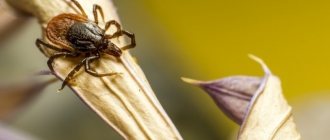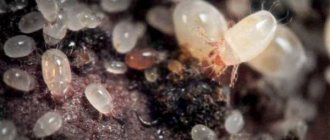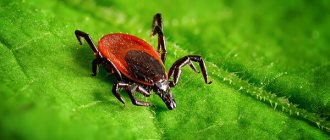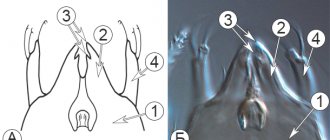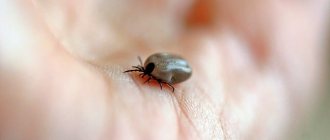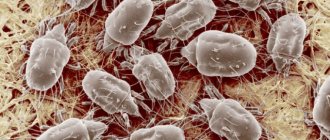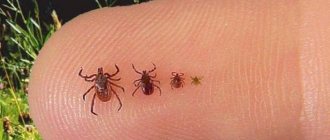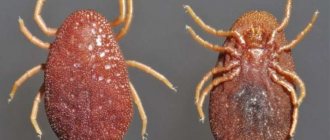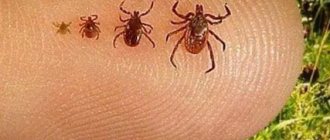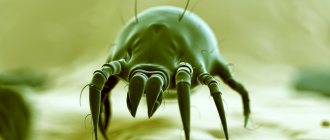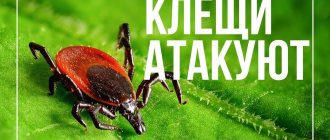You can make forays into nature all your life, go hiking, relax in the summer with your grandmother in the village and still not learn about ticks. Or you can go for a walk in the nearest park and accidentally pick up this dangerous animal.
The tick season begins in early spring (from March) and ends in autumn. Favorable conditions for their existence are air temperature within +20C°, humidity – 80%. Parasites are most active in the spring, when they are just awakening from winter hibernation.
Parasites wake up in early spring during the flowering period of snowdrops and swelling of the buds. As soon as the snow melts and the air warms up, pests crawl out of their shelters. Ticks wake up at a temperature of +1 - +3C°, but become active at +10C°.
The period of tick activity may begin differently in each year. Everything depends on climatic conditions. Ticks appear in the spring after the snow melts and the air warms up, and this can be either the end of March or April. If the winter was harsh, with temperatures dropping to critical levels, the number of parasites will be insignificant.
National problem
These small parasites are most common in forests in the Siberian, Volga, and Ural districts. There are fewer of them in other regions of the country, but even there people suffer from them. Every year, 400,000 Russians go to medical institutions with bites from these arthropods. It is worth noting that a fourth of this figure are children under 14 years of age. Additionally, these statistics do not include individuals who provided treatment at home. Animals also suffer from these leeches: from dogs to goats.
In order to avoid becoming a victim of parasites, you need to know during what period they become active and when the mites disappear.
Today there are more than 48,000 species in nature. This number is associated with evolution. This class lives in the first layers of soil, the chemical and mineral composition of which varies depending on the territory. The length of ticks is usually from 0.2 to 0.4 mm, but there are also giants that reach 5 mm in size.
What causes insect activity?
When parasites are most active depends in any case on temperature. For the insect to begin life, the temperature at which the top layer of soil thaws is sufficient. However, the peak of their “activity” occurs in the warmer seasons.
Periods of insect development
When parasites are most dangerous depends on the stage of development. There are 3 stages.
- The larva feeds only on the blood of small animals, such as rodents, so humans need not be afraid of it.
- The larva then turns into a nymph and overwinters. In spring, the nymph becomes active, but still feeds on the blood of rodents.
- Only in the 3rd year does an adult individual capable of reproduction form. It is she who poses the greatest danger.
What does active time mean for ticks?
- Firstly, this is the period during which the peak activity of bloodsuckers is observed.
- Secondly, the maximum number of insects, which depends to a lesser extent on the season.
- The peak is recorded when the parasites are in the phase of actively searching for food before reproducing.
- Also a factor of activity is the moment at which the probability of a bite is maximum.
To determine when these factors are effective, that is, when
Fabric with tick
time and how active ticks become, use the flag-clock method. The latter are ordinary white panels the size of a waffle towel. The cloth is placed in forest thickets where insect activity is observed. Based on the number of parasites attached to the tissue, their activity in the current year is calculated.
Weather is a major factor
The parasite attaches itself to the human body through an organ called the hypostome. With its help, it not only holds on to the skin, but also sucks out blood. Irritation occurs in the place where the insect has attached itself. If the parasite is not removed in time, it can lead to dire consequences. The main reason why people suffer from attacks by these creatures is a lack of information. Few people know when ticks appear and disappear.
The first attacks can occur in the early months of spring, when the soil temperature warms up to 0.3 degrees.
Weather conditions greatly contribute to the appearance of ticks. In years when winter is characterized by abnormal heat and spring comes very early, parasites become active extremely quickly and in large numbers. Significant thunderstorms and heavy rains, after which the air temperature rises sharply, also contribute to their appearance. Significant cold is when ticks disappear and cease to pose a danger.
What should I do if bitten by a tick?
First of all, you need to remove the tick from the skin as soon as possible using a thread or a special veterinary device.
Svetlana Tolstova
Infectious disease specialist, therapist with 15 years of experience in a city clinic.
Do not use oil or other fats to remove ticks! Information about their effectiveness is a widespread misconception. After treatment with oil, the tick can “burrow” even deeper under the skin, but it is unlikely to suffocate.
Try not to kill the tick or leave its head under the skin; carefully remove it and place it in a transparent jar with a blade of grass or moistened cotton wool so that it does not die.
Take the jar with a live tick to the laboratory, where it will be examined for the presence of pathogens of serious diseases - encephalitis, Lyme disease.
Unsafe places
This species most often lives in mixed forests and groves. But you can also find it in clearings with tall grass, among bushes. Often their habitat is clearings with old stumps. In order for the parasite to bite, it is not necessary to leave the city limits. Today, well-kept parks, squares and gardens are teeming with them. Moreover, they are found even in places where there are two or three old bushes. You can suffer from them in your own yard. Lots of grass, moisture and warmth - an ideal place to live.
Every year, doctors warn the population about the possible danger and give recommendations on how to properly combat this disease. Epidemiologists determine the time when the greatest activation of parasites occurs and when the ticks disappear.
The weather that people like also suits these arthropods. On warm sunny days, even the laziest parasites go hunting. At such times, they look for a victim to drink blood. But during cold, rainy and frosty weeks, insects, like many other creatures, hide. In their “bunkers” they survive bad weather.
DDT
Scientists do not know the exact causes of tick infestations. Previously, there were two versions, but they turned out to be incorrect. According to the researchers, the ban on burning last year's grass around populated areas and in fields had no effect on the increase in the population of ixodid ticks. The same can be said about the decrease in the intensity of work at agricultural enterprises (according to this version, the number of mites has increased due to the interruption of the regular application of mineral fertilizers to the ecosystem).
At certain levels of humidity and temperature, pest insects exhibit an extraordinary ability to survive. In an active state, an adult tick can go without food for more than 9 months. The life cycle of ixodid ticks is at least 2 years. In the absence of heat or food, ticks enter diapause. That is why they can remain viable for up to 7-10 years. Adults and eggs are able to survive both severe frosts and drought.
More than 200 species of wild animals, domestic animals, livestock and poultry act as donors for ticks. People are attacked by insects much less often. Ticks under diapause conditions show miracles of resistance to acaricides (special anti-tick poisons).
Female ixodid tick on the hunt
The life of ticks is quite difficult to study. If insects are studied in laboratories, here they behave extremely sluggishly. Thus, it is not easy to obtain accurate results consistent with pest behavior under normal conditions. Attempts to create bacterial preparations that destroy tick larvae have failed. After sucking blood, a female tick can lay thousands of eggs. Each of these eggs (after passing through the larval and nymph stages) can become an adult.
Dichlorodiphenyltrichloroethane (DDT or dust) remains the only poison that can stop ticks on a national or regional scale. 30 years ago this remedy was banned in most countries of the world. The thing is that DDT can accumulate in organisms and plants (this drug decomposes very poorly).
It is quite possible that the refusal to treat natural foci of their reproduction with DDT led to the invasion of ticks.
This is interesting. DDT was banned in South Africa later than in other countries (in 1996). The incidence of malaria immediately increased 6.5 times after the ban was issued. The South African authorities decided to choose the lesser of two evils. This is why the ban on the use of DDT was lifted in 2001.
Dangerous hobby
The maximum number of bites occurs from the first half of spring to mid-summer. But you can catch the parasite even at a temperature of +5 degrees. Peak activity is in May and June. If we are talking about the time of day, then most of them are in the morning and evening.
It is worth noting here that even in summer there may be a time when ticks disappear completely. If the season is too hot and dry, then the parasites can hide from the sun until September. But as soon as the temperature drops, they will appear again and terrorize people until October and November, after which they will fall asleep for the entire winter.
This little nuisance can befall mushroom pickers who spend a lot of time in the forests, fishermen doing what they love on the banks of reservoirs, and summer residents working in their gardens.
But people whose hobbies are not related to nature can also suffer from ticks. Sometimes you just need to walk under a tree or touch a bush with your sleeve. The small parasite will cling to the skin quickly and painlessly. But just because these creatures are everywhere does not mean that you can only go into the forest when the ticks disappear. In autumn there are usually fewer of them, but no one is safe from their bite.
Site treatment services
You can meet ticks not only in the wild, but also in suburban gardens and city parks. Acaricidal treatment of the area by SES will help protect yourself and family members from attacks by dangerous blood-sucking individuals.
- an official sanitary service registered with Rospotrebnadzor, offers services for treating areas against ticks using the fog method. This is an effective way to destroy parasites and pests, the main feature of which is the fine spraying of the drug. The aerosol cloud penetrates dense thickets of grass, shrubs, and plant litter and destroys ixodid ticks.
For acaricidal treatment, Dez Group specialists use certified products that have been tested for effectiveness and safety for humans and animals. The disinfestation process strictly complies with the requirements of methods, approved standards and sanitary norms.
provides an official 1-year contract warranty and offers attractive prices 24% lower than the market average. This cost is due to wholesale purchases of equipment and consumables directly from the manufacturer.
You can leave a request for a call back on the SES “Des Group” website. The manager will call you back in a few minutes and answer all questions. If necessary, exterminators can urgently go to the site within 2 hours.
How to avoid falling into the trap
It's also worth noting that they don't sit on treetops. Usually their observation point is on the lower branches, in tall grass. Many scientists believe that insects generally do not rise above 50-60 cm. When they are especially aggressive, they wait for prey. Their receptors allow you to sense a person or animal at a distance of 10 meters.
But any problem can be prevented. Doctors recommend wearing thick clothing, treating exposed areas of the body with special products, and examining the skin in detail upon returning from a walk.
At home, it is worth mowing the grass and planting the area with plants that are enemies of parasites - thyme and sage.
By following these rules, you don’t have to wait for ticks to disappear from the forest, but you can safely enjoy nature.
Frost and sun are the enemies of parasites
The main sign that these small arthropods have disappeared is frost or heat. Both the first and second creatures are very feared. In summer weather they hide from the sun. But here it should be noted that they survive the slight heat in those places where people go who also want to get away from the scorching rays. Therefore, if an increase in temperature is predicted for only a few days, and the rest of the summer will be moderate, it is better to use protective equipment.
Despite the fact that today hectares of land are treated for various dangerous insects and parasites, some still manage to survive. Even the capital's forests in certain years were full of these small forest leeches. When will ticks completely disappear in the Moscow region? In autumn. In October and November, the chances of becoming a victim of the parasite are minimal. In addition, at this time of year the nature is especially beautiful, and the air is very healing.
